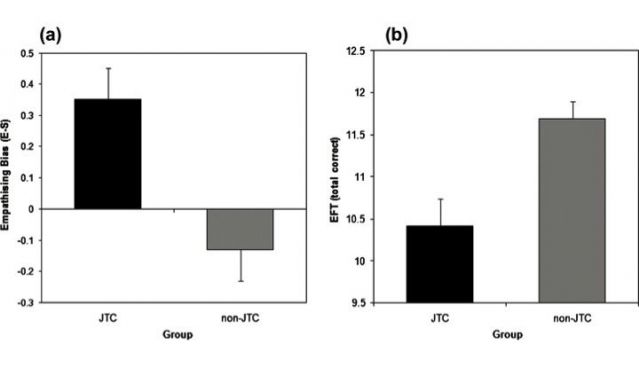Psychosis
Jumping to the Right Conclusion
Jumping to conclusions measures hyper-mentalism as theory predicts.
Posted April 16, 2013

Anyone can jump to conclusions, and many would think I was guilty of having done just that where the diametric model of mental illness is concerned. And to be honest, the idea did come to me originally in one remarkable leap, which I can still vividly recall.
I was thinking about the four basic mechanisms of mind-reading that Simon Baron-Cohen suggested were deficient in autism when it suddenly occurred to me that the world’s most famous psychotic, Schreber, exhibited all four in over-drive: eye-direction detection hypertrophied into his delusions of being watched and spied on; intentionality detection morbidly magnified minor slights into delusions of persecution; Schreber’s over-active shared-attention mechanism became a cancer of the mind that saw conspiracies all around him; and his theory of mind mechanism metastasized into classic delusions of reference epitomized in his belief that his thoughts controlled the weather and caused “miraculous” events to happened all around him.
I had not simply jumped, but made an enormous leap to an astonishing conclusion based on a single case. Was I as mad as Schreber was to think I had discovered what I soon began to call hyper-mentalism? Many certainly think I was—and indeed am mad to have persisted with it (admittedly after much initial uncertainty: but of course that only compounds the felony).
What we need is evidence, and I have already drawn attention to much of what there is in previous posts. But by far the best came from researchers using Baron-Cohen’s empathizing/systemizing dichotomy, rather than the imprinted brain theory’s mentalistic/mechanistic one.
However, as some of the same authors remark in their report of a new study, the previous ones “relied solely upon self-report measures of psychosis. Stronger evidence for the autism-psychosis model”—the diametric one, in other words—“would be provided if the same cognitive pattern of results was found utilizing mainly objective measures.”
The measure they used was a person’s tendency to jump to conclusions because research has consistently shown that many people who experience delusions tend to do this. Specifically, the researchers used a computerized version of
the jumping to conclusions (JTC) beads task. The task involves two jars filled with beads, with different ratios of coloured beads found within them. One jar contains 60 black beads and 40 white beads, and a second jar contains 40 black beads and 60 white beads. One jar is chosen and beads are then drawn and shown to participants one at a time until they make a decision about which jar they think the beads are being drawn from. Participants who make a decision based on two beads or fewer are classified as showing a “JTC” reasoning bias.
They add that “Experiments using the beads task have shown that half or more of clinical patients with delusions show the JTC reasoning bias.” Another way of saying the same thing is that jumping to conclusions can be seen as an example of hyper-mentalizing because it involves over-interpreting or over-reacting to a stimulus. For example, on the basis of what were I am sure a few real experiences, Schreber concluded that there was a conspiracy among the patients in the asylum where he was living to prevent him going to the lavatory by ensuring that all the cubicles were occupied whenever he needed to go there. Indeed, even the most rational of human beings can sometimes be prey to somewhat similar feelings in frustrating circumstances. Most of us realize that we are just jumping to conspiratorial conclusions too readily, and don’t hyper-mentalize to Schreber’s extent, but the difference is purely one of degree. Indeed, this is a major virtue of the theory: it sees mental illnesses as inevitable deviations from normal mentalizing, rather than discrete diseases or pathological afflictions unconnected with normality.

Using Baron-Cohen’s empathizing/systemizing measures I explained in the earlier post, the researchers found that jumping to conclusions (JTC) correlated with measures of empathizing bias (E-S), or what I would call mentalism (above left). A measure of mechanistic cognition however (the embedded figure test or EFT) was found to correlate with not jumping to conclusions so readily (non-JTC right above). The researchers comment that
This research can help us better understand the nature of psychosis spectrum disorders, including schizophrenia with positive symptoms. If the same cognitive pattern reported here is also evident in people with clinical psychosis, as theoretical models predict (e.g. Crespi & Badco[c]k, 2008), then this line of investigation could potentially offer some simple empirical tests to help in diagnosing people with psychosis. Furthermore, if clinical psychosis is characterized by hyper-Mentalizing, then this provides a target for interventions to focus on for alleviating symptoms, and measures to help determine the rate of success of recovery from psychosis.
The authors conclude that what they found “is the opposite pattern to autism and therefore consistent with the autism-psychosis model which proposes that these clinical disorders reside at diametrically opposing poles of a single continuum.”
And as I pointed out in relation to the previous study by these authors, researchers who use one theory’s tools to validate the conclusions of another can hardly be suspected of jumping to conclusions!
(With thanks to John Read.)


